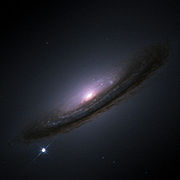
Hubble Bubble (astronomy)
Encyclopedia

Monopole
Monopole may refer to:*Magnetic monopole, or Dirac monopole, a hypothetical particle that may be loosely described as a magnet with only one pole, or related concepts in physics and mathematics:...
in the peculiar velocity
Peculiar velocity
Peculiar motion or peculiar velocity refers to the true velocity of an object, relative to a rest frame.-Galactic astronomy:In galactic astronomy, the term peculiar motion refers to the motion of an object through space.Local objects are usually related in terms of proper motion and radial...
field
Field
-Places:* Field, British Columbia, Canada* Field, Minneapolis, Minnesota, United States* Field, Ontario, Canada* Field Island, Nunavut, Canada* Mount Field - Expanses of open ground :* Field...
, perhaps caused by a local void
Local Void
The Local Void is a vast, empty region of space, devoid of matter, located within the Virgo Supercluster and lying adjacent to our own Milky Way galaxy. Discovered by Brent Tully of the American Astronomical Society in Honolulu, Hawaii, the Local Void is millions of light years in length, the exact...
in the mass density."
The Hubble Constant, named for astronomer
Astronomer
An astronomer is a scientist who studies celestial bodies such as planets, stars and galaxies.Historically, astronomy was more concerned with the classification and description of phenomena in the sky, while astrophysics attempted to explain these phenomena and the differences between them using...
Edwin Hubble
Edwin Hubble
Edwin Powell Hubble was an American astronomer who profoundly changed the understanding of the universe by confirming the existence of galaxies other than the Milky Way - our own galaxy...
, whose work made clear the expansion of the universe
Metric expansion of space
The metric expansion of space is the increase of distance between distant parts of the universe with time. It is an intrinsic expansion—that is, it is defined by the relative separation of parts of the universe and not by motion "outward" into preexisting space...
, measures the rate at which expansion occurs. In accordance with the Copernican principle
Copernican principle
In physical cosmology, the Copernican principle, named after Nicolaus Copernicus, states that the Earth is not in a central, specially favored position. More recently, the principle has been generalized to the relativistic concept that humans are not privileged observers of the universe...
that the Earth is not in a central, specially favored position, one would expect that measuring this constant at any point in the universe would yield the same value. If, on the other hand, Earth were at or near the center of a very low-density region of interstellar space
Interstellar Space
Interstellar Space was one of the final studio albums recorded by the saxophonist John Coltrane before his death in 1967, originally-released posthumously by Impulse! Records on LP in 1974.-Composition:...
(a relative void), denser material in a shell around it would strongly attract material away from the centerpoint. Thus, stars inside such a "Hubble bubble" would accelerate away from Earth much faster than the general expansion of the universe. This situation would provide an alternative to dark energy
Dark energy
In physical cosmology, astronomy and celestial mechanics, dark energy is a hypothetical form of energy that permeates all of space and tends to accelerate the expansion of the universe. Dark energy is the most accepted theory to explain recent observations that the universe appears to be expanding...
in explaining the apparent accelerating universe
Accelerating universe
The accelerating universe is the observation that the universe appears to be expanding at an increasing rate, which in formal terms means that the cosmic scale factor a has a positive second derivative, implying that the velocity at which a given galaxy is receding from us should be continually...
.
Hubble Bubble proposed
In 1998, Zehavi et al. reported evidence in support of a Hubble bubble. The initial suggestion that local redshiftRedshift
In physics , redshift happens when light seen coming from an object is proportionally increased in wavelength, or shifted to the red end of the spectrum...
velocities differ from those seen elsewhere in the universe was based on observations of Type 1a supernovae, often abbreviated "SNe Ia." Such stars have been used as standard candle distance markers for 20 years, and were key to the first observations of dark energy
Dark energy
In physical cosmology, astronomy and celestial mechanics, dark energy is a hypothetical form of energy that permeates all of space and tends to accelerate the expansion of the universe. Dark energy is the most accepted theory to explain recent observations that the universe appears to be expanding...
.
Zehavi et al. studied the peculiar velocites of 44 SNe Ia to test for a local void, and reported that Earth seemed to be inside a relative void of roughly 20% underdensity, surrounded by a dense shell, a "bubble".
Testing the hypothesis
In 2007, Conley et al. examined the SNe Ia color data comparisons while taking into account the effect of cosmic dust in external galaxies. They concluded that the data did not support the existence of a local Hubble Bubble.In 2010, Moss et al. analyzed the Hubble Bubble model although without using that name, saying "The suggestion that we occupy a privileged position near the center of a large, nonlinear, and nearly spherical void has recently attracted much attention as an alternative to dark energy." Looking not only at supernova data but also at the cosmic microwave background spectrum
Cosmic microwave background radiation
In cosmology, cosmic microwave background radiation is thermal radiation filling the observable universe almost uniformly....
, Big Bang nucleosynthesis
Big Bang nucleosynthesis
In physical cosmology, Big Bang nucleosynthesis refers to the production of nuclei other than those of H-1 during the early phases of the universe...
and other factors, they concluded that "voids are in severe tension with the data. In particular, void models predict a very low local Hubble rate, suffer from an "old age problem", and predict much less local structure than is observed."

